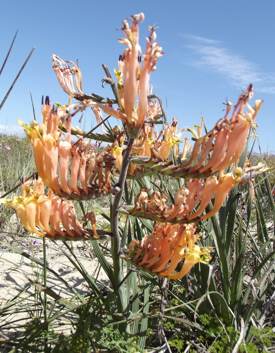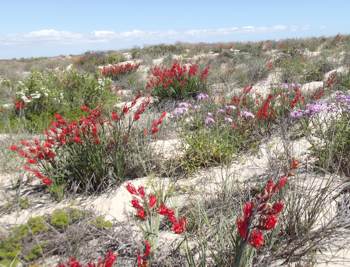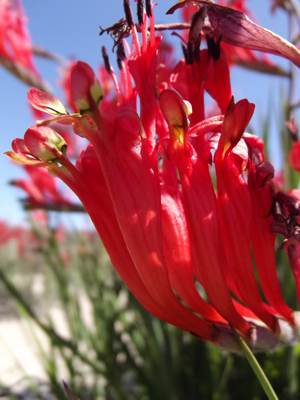Babiana hirsuta
Babiana hirsuta (Lam.) Goldblatt & J.C.Manning (= Babiana thunbergii Ker Gawl.)
Family: Iridaceae
Common names: red babiana (Eng.); rooibobbejaantjie, rooihanekam, strandlelie, sandlelie (Afr.)
Introduction
Babiana hirsuta is a striking, robust, geophytic perennial that produces brilliant but unusual recurved red flowers on long flowering stems.

Description
Description
Babiana hirsuta is a deciduous plant that possesses corms with long necks covered with tough and fibrous tunics. The plants have stems that can easily reach 50 cm, with at least half of their length underground. Several tough, hairy branches are either horizontal, ascending or erect.
The lanceolate leaves may reach a length of up to 30 cm, are ribbed and sometimes minutely hairy.
The showy flowers are carried on horizontal racemes and vary in colour from bright red to shades of orange and apricot. Flowers are 2-lipped and closely set on the stem, reaching a length of approximately 55 mm. The bracts are 20 mm long and are covered with silvery hairs. Flowering is influenced by rain but generally occurs in spring from August until October.

Conservation Status
Status
Babiana hirsuta occurs in fairly large numbers throughout its distribution range and is not known to be threatened.
Distribution and habitat
Distribution description
Babiana hirsuta has a narrow distribution range which is restricted to the south-west coast of Namibia and the north-west coast of South Africa. Populations are found slightly inland from the coast but predominantly along the coastal plains and dunes of Namaqualand where plants benefit from the deep white sands of the west coast.

Derivation of name and historical aspects
History
Early botanical records indicate that Babiana hirsuta was first collected by Carl Thunberg in 1774 on the Cape west coast in the vicinity of Verlorenvlei. The plant was described soon after its discovery by Linnaeus in 1781 and was named Antholyza plicata. However, in 1804 Ker Gawler gave it the replacement name of Babiana thunbergii after its first collector, and due to its close relationship to Babiana, because there already existed a Babiana plicata at the time which dated from 1803. Recently B. thunbergii has been included in Babiana hirsuta.
The name Babiana is derived from the early Dutch name baviaantjie, meaning little baboon which relates to observations made by early Cape colonists who noticed that baboons had a particular liking for the corms of these plants. It is therefore not surprising that the corms of these plants are buried deep in sandy soils, wedged between rocks or found in deep stony gravels, all in aid of protecting the corms from predation by baboons and other mammals. The species epithet hirsuta refers to the minutely hairy leaves.
Ecology
Ecology
Babiana hirsuta produces ample nectar and the flowers are clearly adapted for sunbird pollination. Bees have also been observed on the plants. Both dusky sunbirds (Nectarinia fusca), and malachite sunbirds (N. violacea ) have been seen visiting the flowers. The corms are eaten by baboons.

Uses
Use
Babianas are interesting and rewarding plants to grow in clusters between rocks in rocky gardens, in deep sandy soil, and inbetween retaining blocks or paving stones. They make stunning pot specimens provided that they are given plenty of deep sandy soil and are watered well during the winter and early spring.
Growing Babiana hirsuta
Grow
Seeds can be sown in March and April, and transplanting of the corms is easily done during the resting phase, which is from January to March. There should be at least 5-cm wide spaces between the corms when planting into the garden or in pots. A deep watering, at least once a week, is essential for container plants to ensure that the water reaches the deep corms. The seeds are best sown in autumn, but only thinly to prevent overcrowding. Regular watering is needed during the growing season particularly in winter; this can be done manually with a fine rose on a small watering can. Seedlings must be left for at least two years before they are transplanted into containers or into garden beds.
Babiana hirsuta prefers full sun to flower properly and, since plants are deciduous, they like to be kept dry during the summer months. Other plants to consider when gardening with Babiana hirsuta include B. ringens, B. striata, B. cedarbergensis and B. grandiflora.
References
- Goldblatt, P. & Manning, J.C. 2007 . A revision of the southern African genus Babiana, Iridaceae: Crocoideae. Strelitzia , Pretoria.
- Goldblatt, Manning & Gereau. 2008 Bothalia 38:49-55.
- Le Roux, A. 2005. Namaqualand. South African Wild Flower Guide 1. Botanical Society of South Africa, Cape Town.
- Manning, J., Goldblatt, P. & Snijman, D. 2002. The color encyclopedia of Cape bulbs. Timber Press, Cambridge.
- Smith, C.A. 1966. Common names of South African plants. Memoirs of the Botanical Survey of South Africa No 35. Government Printer, Pretoria.
Credits
Werner Voigt
Karoo Desert National Botanical Garden, Worcester
June 2013
Plant Attributes:
Plant Type: Bulb
SA Distribution: Northern Cape, Western Cape
Soil type: Sandy
Flowering season: Spring, Early Summer
PH: Alkaline, Neutral
Flower colour: Red, Pink, Cream, Orange
Aspect: Full Sun
Gardening skill: Easy
Special Features:
Horticultural zones








Rate this article
Article well written and informative
Rate this plant
Is this an interesting plant?
Login to add your Comment
Back to topNot registered yet? Click here to register.